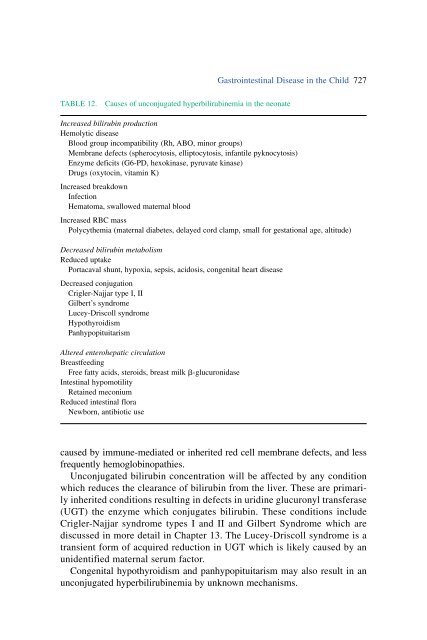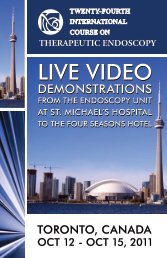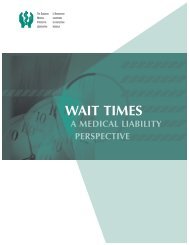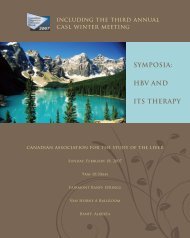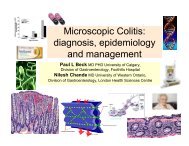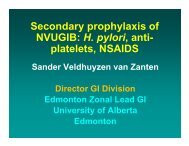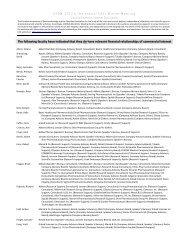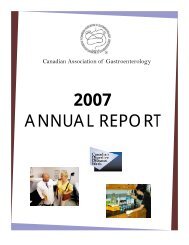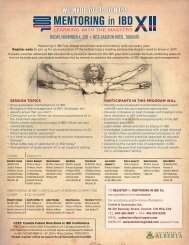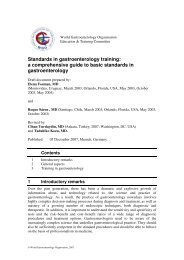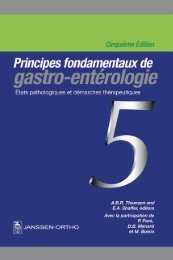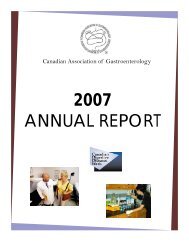Manifestations of Gastrointestinal Disease in the Child
Manifestations of Gastrointestinal Disease in the Child
Manifestations of Gastrointestinal Disease in the Child
You also want an ePaper? Increase the reach of your titles
YUMPU automatically turns print PDFs into web optimized ePapers that Google loves.
<strong>Gastro<strong>in</strong>test<strong>in</strong>al</strong> <strong>Disease</strong> <strong>in</strong> <strong>the</strong> <strong>Child</strong> 727<br />
TABLE 12.<br />
Causes <strong>of</strong> unconjugated hyperbilirub<strong>in</strong>emia <strong>in</strong> <strong>the</strong> neonate<br />
Increased bilirub<strong>in</strong> production<br />
Hemolytic disease<br />
Blood group <strong>in</strong>compatibility (Rh, ABO, m<strong>in</strong>or groups)<br />
Membrane defects (spherocytosis, elliptocytosis, <strong>in</strong>fantile pyknocytosis)<br />
Enzyme deficits (G6-PD, hexok<strong>in</strong>ase, pyruvate k<strong>in</strong>ase)<br />
Drugs (oxytoc<strong>in</strong>, vitam<strong>in</strong> K)<br />
Increased breakdown<br />
Infection<br />
Hematoma, swallowed maternal blood<br />
Increased RBC mass<br />
Polycy<strong>the</strong>mia (maternal diabetes, delayed cord clamp, small for gestational age, altitude)<br />
Decreased bilirub<strong>in</strong> metabolism<br />
Reduced uptake<br />
Portacaval shunt, hypoxia, sepsis, acidosis, congenital heart disease<br />
Decreased conjugation<br />
Crigler-Najjar type I, II<br />
Gilbert’s syndrome<br />
Lucey-Driscoll syndrome<br />
Hypothyroidism<br />
Panhypopituitarism<br />
Altered enterohepatic circulation<br />
Breastfeed<strong>in</strong>g<br />
Free fatty acids, steroids, breast milk -glucuronidase<br />
Intest<strong>in</strong>al hypomotility<br />
Reta<strong>in</strong>ed meconium<br />
Reduced <strong>in</strong>test<strong>in</strong>al flora<br />
Newborn, antibiotic use<br />
caused by immune-mediated or <strong>in</strong>herited red cell membrane defects, and less<br />
frequently hemoglob<strong>in</strong>opathies.<br />
Unconjugated bilirub<strong>in</strong> concentration will be affected by any condition<br />
which reduces <strong>the</strong> clearance <strong>of</strong> bilirub<strong>in</strong> from <strong>the</strong> liver. These are primarily<br />
<strong>in</strong>herited conditions result<strong>in</strong>g <strong>in</strong> defects <strong>in</strong> urid<strong>in</strong>e glucuronyl transferase<br />
(UGT) <strong>the</strong> enzyme which conjugates bilirub<strong>in</strong>. These conditions <strong>in</strong>clude<br />
Crigler-Najjar syndrome types I and II and Gilbert Syndrome which are<br />
discussed <strong>in</strong> more detail <strong>in</strong> Chapter 13. The Lucey-Driscoll syndrome is a<br />
transient form <strong>of</strong> acquired reduction <strong>in</strong> UGT which is likely caused by an<br />
unidentified maternal serum factor.<br />
Congenital hypothyroidism and panhypopituitarism may also result <strong>in</strong> an<br />
unconjugated hyperbilirub<strong>in</strong>emia by unknown mechanisms.


